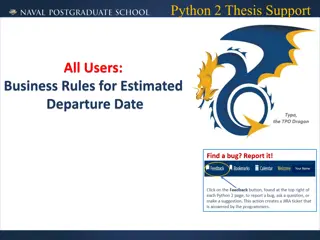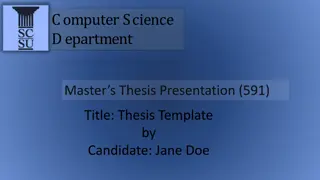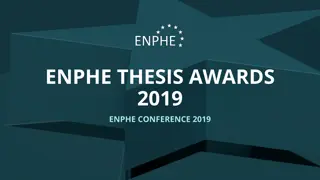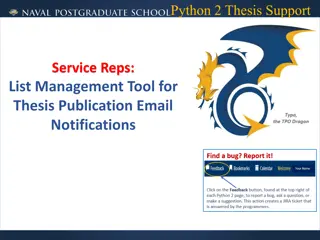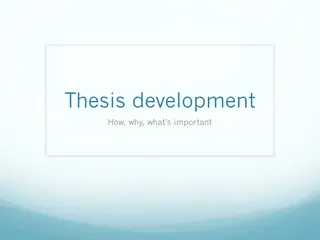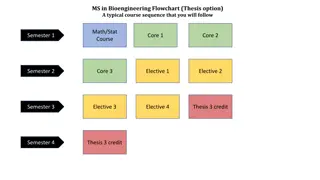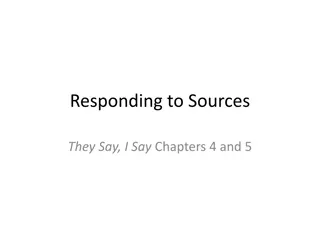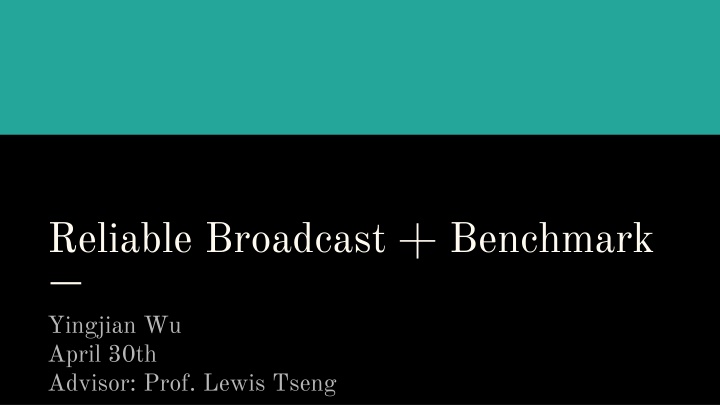
Efficient Reliable Broadcast Benchmarking and Implementation
"Explore the development of efficient algorithms for reliable broadcast systems, along with creating a benchmark tool for assessing their performance. Delve into network models, fault tolerance, and key properties essential for reliable communication."
Uploaded on | 0 Views
Download Presentation

Please find below an Image/Link to download the presentation.
The content on the website is provided AS IS for your information and personal use only. It may not be sold, licensed, or shared on other websites without obtaining consent from the author. If you encounter any issues during the download, it is possible that the publisher has removed the file from their server.
You are allowed to download the files provided on this website for personal or commercial use, subject to the condition that they are used lawfully. All files are the property of their respective owners.
The content on the website is provided AS IS for your information and personal use only. It may not be sold, licensed, or shared on other websites without obtaining consent from the author.
E N D
Presentation Transcript
Reliable Broadcast + Benchmark Yingjian Wu April 30th Advisor: Prof. Lewis Tseng
Accomplishment of My Honor Thesis Table of Contents General Background Algorithms Benchmark tool Benchmark Data
Core tasks I have completed 1. Design and implement new reliable broadcast algorithms that are more efficient in practical network systems, e.g., bandwidth efficiency. 1. Design an automatic and easy-to-use general benchmark system for distributed fault tolerant algorithms
BackGround Knowledge of Broadcast Systems Network Model: 1. Asynchronous network 2. Reliable and Authenticated channels Faulty Model: 1. Tolerates up to f number of faulty servers in the networks 2. Source can also be faulty
Property 1 (Non-faulty Broadcast Termination). Non Faulty Source m: message r: rounds of the broadcast reliable Broadcast(m,r) (m,r) (m,r) (m,r) (m,r) Non-Faulty Server Non-Faulty Server Faulty Server Non-Faulty Server reliable accept(m,r) reliable accept(m,r) reliable accept(m,r)
Property 2 (Validity) m: message r: rounds of the broadcast Non Faulty Source does not broadcast(m,r) Faulty Server Non Faulty Server Non Faulty Server Non Faulty Server does not reliable accept(m,r) does not reliable accept(m,r) does not reliable accept(m,r)
Property 3: Agreement Non-Faulty Server 1 Non-Faulty Server 2 reliable Accept(m, r) reliable Accept(m , r) m = m
Property 4: Integrity m: message r: rounds of the broadcast Physical time 1s 2s 3s 4s .. reliable Accept(m,r ), where r r, r r Non-Faulty Server 1 reliable Accept(m,r ), where r r reliable Accept(m,r)
Property 5: Eventual Termination m: message r: rounds of the broadcast Physical time 1s 2s ... Non-Faulty Server1 Non-Faulty Server2 Non-Faulty Server3 reliable Accept(m,r) reliable Accept(m,r) reliable Accept(m,r)
Hash and Erasure Code Erasure Code [5,3]: Hash: 123456789 encode 1. Assume probability of Hash Collision is small. abc def cfg kdl ssd Hash Collision: H(m) = H(m ), where m m decode 1. widely used technique in Blockchain systems 123456789 Erasure Code: 1. linear [n,k] MDS (Maximum Distance Separable) erasure code over a finite field F? to encode the message. a. n = the total number of codes we need b. k represents the total number of elements needed to decode back a message c. size of individual codeWord = L / k, where L is the size of the original data
Motivation Previous Algorithms 1. proposed to reduce computation, rounds and bits complexity 2. performance are proved theoretically 3. assume unlimited bandwidth (not practical in real world network systems) Our Algorithms: 1. Use Hash and Erasure Code to achieve bandwidth efficiency. a. Crash Tolerant erasure based reliable Broadcast b. Byzantine Reliable Broadcast i. Byzantine Reliable Broadcast using Hash ii. Byzantine Reliable Broadcast using Erasure Codes Practical for the real world network systems 2.
Theoretical Comparison of different algorithms n = number of nodes in the system, L = size of the message
EC-CRB Crash Failures Algorithm: Servers can only stop but no byzantine behaviors (more common in practical network systems) Heuristic idea: 1. Source sends unique codes to individual servers 2. Once the individual servers receive the codes, they broadcast the unique code they receive from the source node
EC-BRB: Source Broadcast (Round 1) code1 Server 1 ecnode(4,3) code2 code3 code4 Server 2 Server 4 Server 3
EC-BRB: Server Echo (Round 2) Server 1 code2 code1 code1 code1 code3 Server 2 Server 4 (Crash) code2 code2 code3 code3 Server 3
Hash-BRB[3f+1] Byzantine failures algorithm: Faulty Servers can have arbitrary faulty behavior much more complicated than crash failure reliable broadcast
Hash-BRB[3f+1] Server Broadcast In most of the asynchronous algorithm, a server just need to receive n - f of the same messages to make sure that all the non- faulty nodes will eventually agree on the same value. Byzantine Server m1 m1 m2 Server2 Server3 Server4
Hash-BRB[3f+1] Server Echo Byzantine Server send H(m1) to sever 2 and server 3 send H(m2) to server4 send H(m1) receive H(m1) from byz server, serve2, and server 3 receive H(m2) from server 4 send H(m2) receive H(m1) serve2, and server 3 receive H(m2) from byz server and server 4 send H(m1) receive H(m1) from byz server, serve2, and server 3 receive H(m2) from server 4 Server3 Server2 Server4
Hash-BRB[3f+1] Server Request Another threshold (f + 1), which is when one of the server see a message that it has not seen before for f + 1 times, then it will make a request of the data from those f + 1 senders Byzantine Server send data m1 send data m1 send request H(m1) Server2 Server3 Server4
Why we build our benchmark tool 1. To our group knowledge, none of the prior algorithms have been benchmarked under practical settings 2. To our group knowledge, no open source benchmark tool for evaluating distributed reliable broadcast algorithms 3. Need automatic tool to start up arbitrary number of nodes. 4. Can tune network parameters to test the bottleneck of the algorithms: a. Bandwidth constraint b. CPU computational power c. Network topology
Benchmark tool (RMB) Benefits using RMB: 1. User-Friendly: a. Users only need to implementing their protocols without worrying about network communications and benchmarking. b. User can easily define node byzantine behavior themselves if necessary. 2. Configurable network settings using Mininet: a. Network Topology b. Server CPU power c. Network bandwidth and latency d. link failure e. ...
Benchmark Server used for benchmark: RMB on a single virtual machine (google cloud platform instance) with 24vCPU 48 GB memory By default, the RTT between individual nodes is between 0.06 ms and 0.08 ms.
Benchmark Result 1: Different Network Topologies Setup: 5 servers and 0 faulty servers under two different network topologies
Benchmark Result 2: Sync vs Async In general, Synchronous system serves a good base line. Digest and NCBA Benchmark Setup: 1. number of servers = 4, 2. message size 1024 bytes, 3. 2000 messages broadcast.
Benchmark Result 3: Hash vs Erasure Code Setup: number of servers = 20, and 100 rounds of reliable broadcast exp1: f = 4, source s bandwidth limitation = 0.4 Mbits/s, message size = 1096 bytes. exp2: f = 4, source s bandwidth limitation = 4 Mbits/s, message size = 1096 bytes. exp3: f = 1, source s bandwidth limitation = 0.4 Mbits/s, message size = 1020 bytes exp4: exp3: f = 1, source s bandwidth limitation = 4 Mbits/s, message size = 1020 bytes.
Future Work 1. This work has been compiled into a paper and is currently under submission for conference. 1. Further refactor the codes, so users can understand the code much easily. 1. Design and implement more byzantine broadcast algorithms that considers other efficiency.
Special Recognition 1. Haochen (Roger) Pan: junior at Boston College a. Helped setup Mininet b. Design and writing proof for new reliable broadcast algorithms 1. Sapta Kumar: post-doc under Prof. Tseng: a. Proofread the proof of the algorithms b. Theoretical Analysis on individual algorithms 1. Prof. Lewis Tseng: supervisor of my Honor Thesis
Reference [1] Ittai Abraham, Yonatan Amit, and Danny Dolev. 2005. Optimal Resilience Asyn- chronous Approximate Agreement. In Principles of Distributed Systems, Teruo Higashino (Ed.). Springer Berlin Heidelberg, Berlin, Heidelberg, 229 239. [2] Hagit Attiya and Jennifer L. Welch. 2004. Distributed computing - fundamentals, simulations, and advanced topics (2. ed.). Wiley. [3] GabrielBracha.1987.AsynchronousByzantineAgreementProtocols.Inf.Comput. 75, 2 (Nov. 1987), 130 143. https://doi.org/10.1016/0890-5401(87)90054-X [4] Damien Imbs and Michel Raynal. 2015. Simple and E cient Reliable Broad- cast in the Presence of Byzantine Processes. CoRR abs/1510.06882 (2015). arXiv:1510.06882 http://arxiv.org/abs/1510.06882 [5]Damien Imbs and Michel Raynal. 2016. Trading o t-resilience for e ciency in asynchronous Byzantine reliable broadcast. Parallel Processing Letters 26, 04 (2016), 1650017. Optimal Multi-valued Asynchronous Byzantine Agreement with Optimal Resilience. In Information Theoretic Security - 5th International Conference, ICITS 2011, Amsterdam, The Netherlands,May21-24,2011.Proceedings.206 226. https://doi.org/10.1007/978-3- 642- 20728- 0_19 [7] Michel Raynal. 2018. Fault-Tolerant Message-Passing Distributed Systems - An Algorithmic Approach. Springer. mhttps://doi.org/10.1007/978-3-319-94141-7 [8] Mininet. http://mininet.org/ [6] Arpita Patra and C. Pandu Rangan. 2011. Communication


